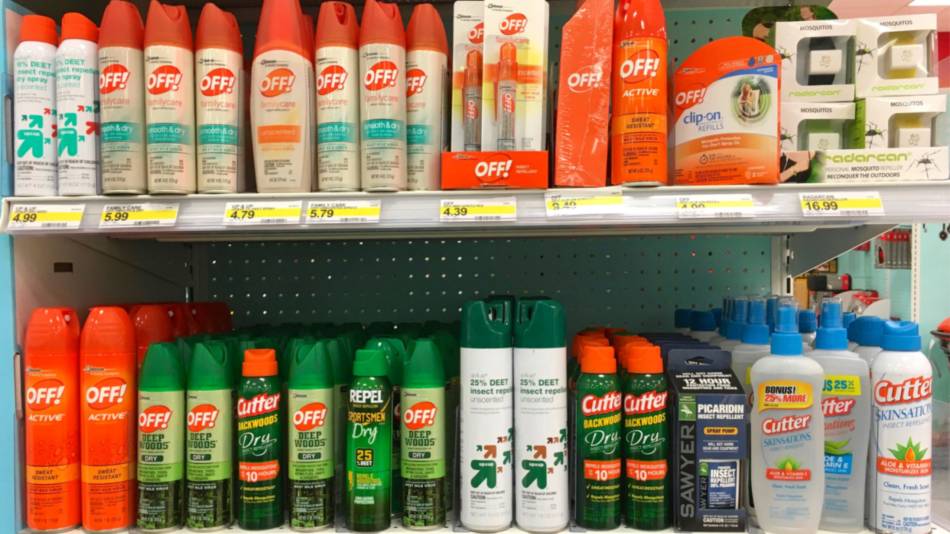Our Members Asked:
What are the best bug sprays to prevent tick and mosquito bites? Is the insecticide permethrin safe to use?

Answer:
Tickborne illnesses such as Lyme disease have more than doubled in the United States since 2004 (CDC, Tickborne Disease Surveillance Data Summary, Accessed 4/25/22). While mosquitoes in the U.S. often cause nothing more serious than itchy, red bumps (which nevertheless can be an annoyance), they also have the potential to transmit serious diseases such as Zika and West Nile virus (EPA 2021). For these reasons, it is important to know which preventative measures – including bug sprays and other strategies — are most effective at helping avoid insect bites.
Steps to help prevent tick or mosquito bites
According to recommendations by the CDC, the following steps should be taken when outdoors to help prevent bug bites:
- Use Environmental Protection Agency (EPA)-registered insect repellent
- Wear permethrin-treated clothing
- Wear long sleeves
- Wear light clothing
- Perform tick checks
- Know how to remove a tick
- Wash and dry clothes at hot temperature
Sign in as a member for more details about tick and mosquito protection, including our Top Pick among mosquito and tick repellents. Also learn whether these repellents work on biting flies, can be used on pets (dogs or cats), are safe on clothing (including sun-protection clothing), expire over time, should be applied before or after sunscreen, and about a reported link to Parkinson's disease.
Products discussed and compared in this article include Avon Skin-So-Soft Bug Guard Plus Picaridin Insect Repellent Spray, Control Solutions Permethrin SFR 36.8% Concentrate Insecticide, Cutter Insect Repellent SS, Durvet Permethrin 10% Rapid Kill Insecticide, OFF! FamilyCare Insect Repellent II, Repel Permethrin Clothing & Gear Insect Repellent, Sawyer Premium Insect Repellent 20% Picaridin Spray Pump, and Sawyer Premium Permethrin Insect Repellent Aerosol Spray, as well as fabrics impregnated with Insect Shield (such as ExOfficio, Craghoppers, and Cresta).
Join today to unlock all member benefits including full access to all CL Answers and over 1,400 reviews.
Join NowAlready a member? Sign In Here.
Join now at www.consumerlab.com/join/








TW
June 16, 2024We have a bumper crop of mosquitoes, buffalo gnats and other biting insects right now. I am a magnet for them. I used rolled up paper towels and put a few drops of tea tree oil on it, draped around my neck and put tea tree oil on a hat. Seems to work. I did not get a single bite since wearing it. They buzz around me but don't land. I will cut off some socks and drape around my ankles to see if it works for chiggers.
Reply to this post…
Georgia19719
June 15, 2024We have used Cedarcide for years. We spray it on the area we will be sitting abd also on ourselves. The company claims it is safe for children and pets but I find little evidence of anything supporting this product. Just wondering if anyone knows of any reviews that are unbiased.
 ConsumerLab.com
ConsumerLab.com
June 18, 2024Most products by Cedarcide contain cedar oil as the active ingredient. As noted in our article, cedar oil is classified as a minimum risk pesticide, which means it is not EPA-registered and its effectiveness has not been confirmed, although it is unlikely to pose safety concerns: https://www.consumerlab.com/answers/are-permethrin-tick-sprays-safe-on-sheets-clothing/permethrin/#minimum-risk-pesticide
Reply to this post…
Susan19707
June 14, 2024Landscaping on a Florida estuary where mosquitos will dive bomb you before 8:30 am. Successfully holding them at bay with Repel Lemon/Eucalyptus neck up (particularly my ears), Off Deep Woods on my feet and ankles (flip flops), and Sawyer Picardian for clothing on my hat, long loose pants (mosquitos will bite through tight clothing), and sun jacket. Also keeping no-seeums off me.
Reply to this post…
Gene19703
June 14, 2024Years ago, I used a Picaridin product and found it ineffective during Western high altitude backpacking, so went back to Deet. However, when I was preparing for trips to southern Africa and Guadeloupe I used Sawyer’s permethrin on my clothes and found it effective.
Reply to this post…
GettingCrunchy
May 24, 2024Could you address the safety of petroleum distillates in Sawyer (or other permethrin for clothing) permethrin?
 ConsumerLab.com
ConsumerLab.com
June 21, 2024Thanks for your question. We've added information about this to the following section of our article: https://www.consumerlab.com/answers/are-permethrin-tick-sprays-safe-on-sheets-clothing/permethrin/#petroleum
Reply to this post…
Ruth19124
March 27, 2024Oil of rose geranium is known to repel ticks. Can be used on dogs and smells like roses. I have put it on outdoor cat bedding and the cats didn't seem to mind. Rose geranium is also used to treat skin issues.
 ConsumerLab.com
ConsumerLab.com
April 01, 2024Thank you for sharing! Be aware that the American Kennel Club recommends talking with your veterinarian before using essential oils on your pet for flea and tick control, as there is a lack of data supporting the success of these products when used alone, and some may be unsafe for your pets: https://www.akc.org/expert-advice/health/are-essential-oils-safe-for-dogs/
Reply to this post…
G
March 26, 2024Can you apply permethrin to UPF 50 clothing? Does it interfere with the sunblocking effect of the clothing that blocks the sun? For example, Coolibar. Eddie Bauer, REI, Columbia all sell sin orotective clothing and hats which many people, including myself, wear for hiking and outdoor activities. Please advise.
 ConsumerLab.com
ConsumerLab.com
March 29, 2024Please see the following section of our article: https://www.consumerlab.com/answers/are-permethrin-tick-sprays-safe-on-sheets-clothing/permethrin/#permethrin-sun-protection-clothing
Reply to this post…
Jeffrey19090
March 26, 2024My wife and I have been wearing Insect Shield treated clothing in the warm months to include socks, pants, shirts and hats, and neither one of us has had a tick bite in years. And there are lots of ticks in our part of Massachusetts. Also, we've washed this clothing numerous times before having it retreated, without any problems. You can send any article of clothing to them and have it treated for a very modest charge. (BTW, I am in no way connected to Insect Shield).
Zora19724
June 16, 2024I have had many articles of clothing treated as well. This spring my husband and i camped on the oregon coast for two weeks. On the one day he didn’t wear his treated pants he had two ticks, but I had none. Buying their bags is an economical way to get clothes treated.
Reply to this post…
Hilene13900
April 23, 2023Is there an expiration date for this product. Does it last longer than one year?
 ConsumerLab.com
ConsumerLab.com
April 28, 2023We've added information about the expected shelf-life of insect repellents in the following section of our article: https://www.consumerlab.com/answers/are-permethrin-tick-sprays-safe-on-sheets-clothing/permethrin/#shelf-life
Reply to this post…
Jeffrey13897
April 22, 2023Please don't forget the #1 most important way to reduce mosquito exposure. Eliminate all standing water. Even the tiniest amount creates the ideal place for them to reproduce. During the construction of the Panama Canal in the early 1900's, vast numbers of workers became ill or died from malaria spread by mosquitos. Eradicating all standing water cut the number dramatically.
William13898
July 02, 2023Yes, very important. Sadly, most people don't take that seriously, and leave surfaces lying around their yard or in vacant lots that collect water, old tires being noteworthy.
Merilee19104
March 26, 2024Excellent point, thanks for bringing it up. Even a paper cup left outside in the rain for a few days can hatch mosquitoes.
Reply to this post…
Gene13895
April 21, 2023For the past 15 years I lived in the upper Rockies, and from Spring to Fall hike once or twice a week hike in the in local mountains, from the Bridgers and Gallatins to Yellowstone National Park, as well as occasionally camp in the latter. Before that, I frequently backpacked in the eastern Sierra and Yosemite. That's given me plenty of opportunity to try different repellants. I started with Picaridin and found it simply didn’t work for me, which is why I then turned to and still use Deet based ones. I know that I’m hardly alone in this, both from what my hiking partners have recounted, as well as from the customer reviews of Picaridin-based repellents on REI’s website.
Reply to this post…
Carol13891
April 14, 2023I was bitten mercilessly as a child by mosquitoes, yet barely attract any mosquitoes today. I'm not outside quite as much at dusk in summer as I was as a child, and for sure my skin is not as tender (!) but I am convinced that what explains the drastic difference most is my diet. As a child 80% of my diet was bread, pasta, cookies, crackers, pretzels and so forth; now I eat an unprocessed low-carbohydrate diet which must drastically change my blood and my skin microbiome. I am no longer appetizing to mosquitoes!
Susan S19832
June 24, 2024My husband’s diet is like yours as a child was. Mosquitoes have never been attracted to him. Once, while camping, he slept on top of the sheets so they’d seek him out rather than me! On the other hand, my diet has never been hi-carb (and is now near-Keto; they still love me).
Reply to this post…
Sherrykt
June 07, 2022I was told to purchase a 100% Deet product. Is this overkill?
 ConsumerLab.com
ConsumerLab.com
June 10, 2022We've added information to answer your question in the following section of the article above: https://www.consumerlab.com/answers/are-permethrin-tick-sprays-safe-on-sheets-clothing/permethrin/#deet
Reply to this post…
Joseph13887
June 01, 2022Its a good idea to take a small bottle with you to save the removed tick in. A tick expert can then identify the species and rule out any or possibly all diseases. You may be able to do the same yourself immediately with tick photo-identifying card.
Reply to this post…
Sandra Collins
May 29, 2022Going to Africa (Botswana) - does the Sawyer 20% Picaridin repel mosquitos that carry malaria? Would DEET be a better option, and have you done a review on DEET products? TY so much for the permethrin recommendation as we will be spraying all our clothes.
 ConsumerLab.com
ConsumerLab.com
June 03, 2022The CDC does not recommend DEET over picaridin for preventing mosquito and tick bites when traveling: https://wwwnc.cdc.gov/travel/page/avoid-bug-bites. Any EPA-registered product containing either of these ingredients would be acceptable (and Sawyer 20% picaridin is EPA-registered).
Sandra Collins
June 03, 2022Thank you!
Sandra Collins
June 03, 2022Would Ranger Picardin 20% also good? I think I read that Ranger gives 12 hours of protection in CL, but don’t remember. Thank you again!
 ConsumerLab.com
ConsumerLab.com
June 10, 2022We discuss Ranger Ready Repellents Tick + Insect Pump Spray (which contains 20% picaridin) in the following section of our article above: https://www.consumerlab.com/answers/are-permethrin-tick-sprays-safe-on-sheets-clothing/permethrin/#toppick-repellent
Reply to this post…
Sharon13880
May 27, 2022Best tick remover tool that I have used is the Tick Removal Kit from www.tickinfo.com/protickremedy. The tick remover slides against the skin under the tick's body. Then you pull slowly straight out and away from the skin surface. https://tickinfo.com/wp-content/uploads/2018/02//proticktool.jpg Put the tick in a small container with alcohol and retain in case symptoms arise. Identifying the tick can aid in diagnosing any symptoms.
Reply to this post…
Stephanie13879
May 27, 2022Beware that some repellants are toxic to pets.
Reply to this post…
Jean13877
May 27, 2022How do you dispose the wash water if not down the drain?
 ConsumerLab.com
ConsumerLab.com
June 03, 2022We've added information to answer your question in the following section of the article above: https://www.consumerlab.com/answers/are-permethrin-tick-sprays-safe-on-sheets-clothing/permethrin/#permethrin-disposal
Reply to this post…
Ann13876
May 27, 2022Not really about tick prevention, but if you do find a tick on you and then you get sick within the next week or so, go immediately to Urgent Care or your doctor and tell them you were bit by a tick and insist on taking antibiotics right away because they will test you, but it takes about a day to get the results back. This happened to me, and it turns out I did have Rocky Mountain Spotted Fever. My symptoms subsided after my first dose of antibiotics but my platelets dropped dangerously low. My doctor later told me that it rarely happens that people associate the tick bite with the illness and usually get very sick and have to be hospitalized before it's discovered and treatment starts. So thankful I learned what to do from my son's Boy Scout camping experiences.
Reply to this post…
Jacelyn13873
May 03, 2022Another tip to keep ticks at bay: tuck your pants legs inside the tops of your socks. It may look a bit nerdy, but it makes it less likely the the ticks will get inside your pants leg and onto your skin. Our ticks are prone to climb up skin, clothing, etc. before they bite, and they are more visible when outside your clothing than inside your clothing and more in contact with permethrin treatments on your clothing. Likewise, tuck in your shirts.
William19746
June 18, 2024I have found it effective to use permethrin treated pants and socks and then tie a shoe string around the pants near the bottom to constrict the pants against the socks in that area. I causes any ticks trying to climb up to be greatly slowed down in their journey and trapped from above and below them by a permethrin treated clothing layer. Impossible for them to get past the constricted area before dying. The problem is changing clothes after hiking and have your canine hiking partner brush against you and transfer a perfectly happy and healthy tick onto you. Giving your dog a tick preventive orally (NOT a Seresto Collar!!) will greatly help. A few ticks might get left in the house crawling on carpet or up walls or furniture, but there is only so much you can do. Can't live paranoid about tick born diseases. What about human-born diseases. Might as well never go out in public.
Reply to this post…
Karen13868
April 26, 2022We live on a farm (plenty of deer, plenty of ticks) and send our work clothes to Insect Shield to be professionally treated, good for 70 washings (https://www.insectshield.com). Also, to safely remove a tick, Do NOT use tweezers!! Unfortunately many sites still carry that TERRIBLE advice! A much safer, MUCH more effective solution is using the Tick Twister (https://ticktwister.com) (also available at Walmart). Because the tick's mouthparts are barbed, it releases quickly and easily when twisted (much as you would remove a screw by unscrewing it -- not prying with a hammer). The problem with tweezers is you are much more likely to end up squeezing the pathogens out of the tick and into your bloodstream -- and frequently you pull the body off and the head (containing all those nasty pathogens) remains imbedded. In contrast, with the Tick Twister, we were able to safely remove a tick from the rim of one of our chicken's eye -- something we would never attempt with a tweezers. Having attended 8 medical conferences specific to tickborne-disease, let me dispel the myth that a tick has to be attached for hours for infection to occur -- in fact, infection CAN be transmitted immediately if the mouthparts of the tick are infected. It's just safer to assume that every tick is infected and get treated by a Lyme-literate doctor. Most providers receive little or inaccurate information about the complexities of tickborne-diseases, which are often hard to diagnose and treat, but must be taken very seriously and acted upon immediately.
Frances13871
April 27, 2022In any of those medical conferences devoted to ticks, did you hear of any studies being done on the twister vs. needle nose tweezers, which is what the academics invariably recommend? I figured they would be on the twister site, but they're not. I realize that faced with the reality of ticks, personal experience is all you need, but if there's research to back it up, that would be great. Personal experience: not mine, but a friend who was on a hike in the Catskill mountains with a small group of friends and suddenly someone had a tick attached to her forearm. No one had tweezers or a tick key or anything to remove it. One woman knew what to do: she gathered a bit of her own spit on her forefinger and slowly traced three circles closely around the feeding tick, using mild pressure. Once she finished, the tick almost immediately let go.
Wonder if anyone else has ever heard of this trick or tried it?
William19748
June 18, 2024All of this is exaggerated. Just grab the tick with your fingers close to where it is attached and pull gently until the tick gives up and lets go. Then flush it or just throw it back outside. Way too much concern about mouth parts. Can always put an antiseptic on the site and forget about it.
Reply to this post…
Katherine13867
April 26, 2022My son is very picky about bug sprays and sensitive to their smells, and Earth Kind Unscented Mosquito Repellent (which is also effective for ticks) and contains picaridin has been a godsend. (I have
no affiliation with the company. I just buy it regularly!) https://www.earthkind.com/product/stay-away-mosquitoes/ It is EPA Registered according to the Safety Data Sheet. Could be worth adding to the list above for those who are more sensitive.
Reply to this post…
Elizabeth13862
September 16, 2020It is important to know that not "all mammals" react to permethrin in the same way. Permethrin insecticides are deadly to cats. Our cat was on a screen porch when insecticide was sprayed in the yard by the home owner. It nearly killed her.
Don't use insecticides if you can avoid it. Flea collars for dogs are also deadly for cats...a major cause of cancer in cats.
 ConsumerLab.com
ConsumerLab.com
September 28, 2020Great point! Among mammals, cats are indeed more sensitive to permethrin sprays, although the most serious adverse effects seem to occur at high concentrations (45% to 65%). Permethrin toxicity in cats usually occurs when an owner applies a spot-on, flea and tick control product intended for dogs or when a cat is in close contact with a recently treated dog. These spot-on products for dogs contain permethrin in high concentrations. As we note in our article, permethrin yard sprays can also contain high concentrations of permethrin, so these sprays may also be unsafe for cats. The amount of permethrin in sprays intended for treating clothes and outdoor gear is much lower. Provided items treated with these sprays are kept away from cats until they are dry, the treated items are unlikely to cause problems. However, to be extra cautious, people with cats may want to consider using another insect repellants.
Reply to this post…
Robert13861
August 09, 2020I re-apply permethrin every 6 weeks to work pants and shoes, hoping to avoid bites from ticks and chiggers. If you buy a gallon at a time it is around 24 cents per ounce. It seems to work, but I also spray socks, pant cuffs and shoes with DEET before going outside to work.
Reply to this post…
S A13855
August 09, 2020What about the products that have you saturate clothing to treat it--are these safe?
 ConsumerLab.com
ConsumerLab.com
August 10, 2020Soaking or saturating clothing with permethrin solutions is not recommended. It might cause skin irritation, and any leftover solution would need to be discarded appropriately. We've added information about this to the answer above.
S A13858
August 10, 2020Thank you! I have done this numerous times and have not found it to irritate my skin. I'm glad to know there are no more subtle health risks.
Christien13856
July 07, 2021Are there any studies indicating an impact of permethrin upon the human microbiome?
 ConsumerLab.com
ConsumerLab.com
July 08, 2021Permethrin was shown to alter fecal microbiota in an animal study (https://pubmed.ncbi.nlm.nih.gov/26898931/); however, we are not aware of any studies on its effects on the gut microbiome in people.
Reply to this post…